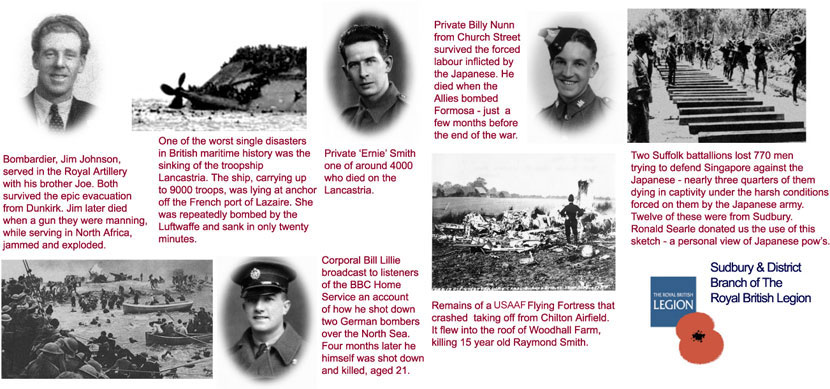

The Sudbury and District Branch Royal British Legion gratefully acknowledges the support of:


Singapore and the tragic aftermathIn February 1942 the Japanese army invaded the island of Singapore from mainland Malaya. With the water supply cut off and no air or sea cover, the fate of the British base was inevitable. What followed was the largest surrender of British troops in history with an estimated 100,000 British and Commonwealth servicemen taken prisoner along with many civilians. These included survivors of the 4th and 5th battalions of the Suffolk Regiment who had landed there only 17 days earlier and fought to defend the island. Among them were men from Sudbury and locality who in peace time had been members of the part-time Territorial Army. Over the next three and a half years the prisoners were subjected to harsh conditions, near starvation and blatant cruelty while working as forced labour in the unremittingly hostile conditions of the tropical climate. They marched and worked while suffering from ulcerated eyes, ulcerated legs and other tropical diseases. They died from malaria, cholera, exhaustion and from beatings by their Japanese guards. One of the half-starved British prisoners of war building the Burma railway drew the sketch above and kept it hidden from the Japanese guards. He became the celebrated cartoonist Ronald Searle. They built the notorious ‘Railway of Death ’ from Burma to Siam (now Myanmar and Thailand) including the bridge over the River Kwai immortalised in the 1957 film. The two Suffolk battalions lost 770 men in the vain bid to defend Singapore, nearly three quarters of them dying in captivity. Among them are eleven men named on the Sudbury War Memorial. Another died in the fighting to defend the island. After the Japanese surrender, images of the liberated survivors shocked the world. Grown men cried at the sight of the prisoners’ skeletal, diseased bodies, some weighing less than six stone. Their suffering, both mental and physical, continued for years - in some cases for the rest of their lives. |

|